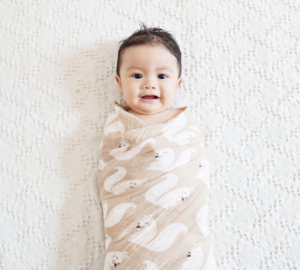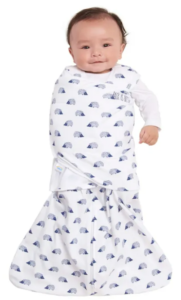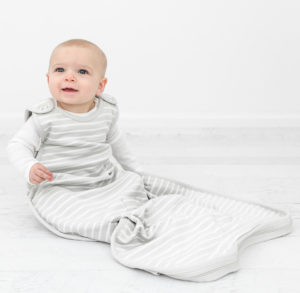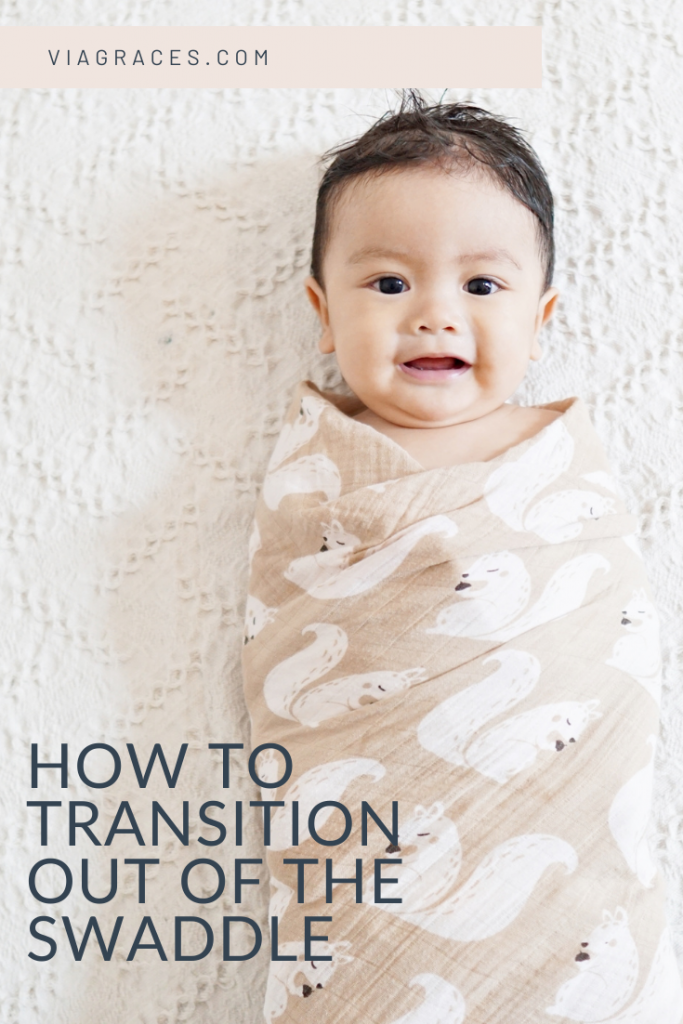One of my favorite aspects of newborn life is that sweet little baby burrito I get to snuggle. Swaddling is such an important piece of newborn sleep, but it’s also something that gets misused!

With my first, we swaddled her for naps and nighttime for four+ months. I actually remember attempting to transition her after Christmas two years ago, but she just wasn’t sleeping well.
So instead of transitioning her out of the swaddle, we just bought the largest size we could find!
Looking back, I think I blamed some of her poor sleep on the swaddle transition rather than her lack of independent skills. (Really, I blamed anything I could think of for her poor sleep because I didn’t want to admit that I didn’t know how to fix it!)
I knew she needed to be arms free by the time she rolled over, but I didn’t know much else. And thankfully for us, she didn’t roll over until closer to 6 months, so we were still “safe.” What I didn’t realize was that by keeping her swaddled, we were actually limiting her ability to self-soothe.
So in this post I’m going to walk you through what I wish I would have known the first time around, including:
- When you should stop swaddling your baby
- Two ways you can transition your baby out of the swaddle
- How your baby’s sleep might change when you stop swaddling
- What sleep sacks to use once you transition out of the swaddle
When to Transition Your Baby Out of the Swaddle
It is very important for our babies’ safety that they are no longer swaddled by the time they start attempting to roll over. Rather than basing the swaddle transition on a physical skill, however, I actually suggest basing the transition on age.
It is ideal to make the transition around 10 weeks; 8 weeks at the earliest, and 12 weeks at the latest. [Note: use your baby’s adjusted age when determining the best time to transition!]
Although that newborn startle reflex might not be totally gone yet, having their hands and arms free is such a big part of learning to self-soothe, so we want to make sure we’re giving them that opportunity.
Additionally, around four months there’s an actual physical change in babies’ sleep as they transition from two sleep cycles to four sleep cycles (ever heard of the four-month regression??). This adjustment in sleep cycles pairs well with gaining more control over their body, so it’s around this four-month mark that babies are able to learn to self-soothe.
With our newest little addition this fall, we stopped swaddling her when she was 10.5 weeks old (9.5 adjusted since she was born a week early). Now at 11 weeks, she’s arms-free!
I knew her time to transition was quickly approaching, plus she had been quite the little swaddle escape artist for a few weeks, so we decided to jump in.
Since we’ve stopped swaddling her, she does 360s in her sleep, so I know she’s figuring out how to use that little body and get comfortable!
How to Go About the Swaddle Transition
Method 1: Swaddle with one arm in, one arm out
This is what we just finished with our little Avery and it’s my go-to if babies are young enough and have not yet attempted to roll over.
If you have something like the SummerMe swaddle, you can transition with it by simply swaddling one arm in and leaving the other arm out.

My favorite sleep sack for transitioning out of the swaddle is the HALO Sleepsack. I love that it allows you to easily swaddle one arm in and one arm out. I also love that once you’re done swaddling and have finished the transition, you can still velcro around your baby’s body to give them that secure feeling that the swaddle used to bring.
So when using the one arm in and one arm out strategy, I suggest starting at bedtime, as melatonin (our natural sleepy hormone) is on your child’s side.
Start by swaddling one arm in and keeping the other arm out of the swaddle. Then for the first night waking, switch arms. Then the next waking, switch again! For the first nap of the day, switch, and continue taking turns with which arm is swaddled in and which is out for three to four days.
Then leave both arms out, and you’re officially done swaddling your baby!
Method 2: Stop Swaddling Cold turkey
If the above method seems too complicated and you’re just ready to stop swaddling your newborn, you can simply stop cold turkey!
Again, I suggest starting at bedtime, as daytime sleep is just harder in general. Then simply walk through your typical bedtime routine, but skip the swaddle, and then support your baby to sleep.
Additionally, if you’re reading this and your baby is already 13+ weeks old, I do suggest you simply stop swaddling cold turkey, to make sure you’re giving your baby all of the freedom to move around and learn to get comfortable, and to make sure you make the switch before they attempt to roll over.
What to Expect When Transitioning Out of the Swaddle
While transitioning out of the swaddle, you may notice it takes longer for your baby to fall asleep; she may need more help getting to sleep than usual, she may have more partial arousals than normal, and she may even have some short naps as a result.
And that’s understandable; this is her first little hands-free party!
Just because you’re no longer swaddling your baby does not mean their startle reflex will instantly go away; it will likely take some time. But transitioning now will help your baby learn more control over their arms and don’t worry, the reflex will go away.
So once you decide it’s time to stop swaddling, make the transition and stick with it!
What to Use When You Stop Swaddling
Whichever method you use to stop swaddling, I am a huge fan of moving into a normal, arms-free sleep sack from here, as it’s not safe to use blankets until your baby is at least 12 months old.

Putting them in a sleep sack gives me the confidence that my babies are warm, plus putting on a sleep sack is a great physical reminder that sleep is coming.
Read about my favorite sleep sacks here!
Do I have to transition from a swaddle to a sleep sack?
No! Your baby can absolutely be a great sleeper and not have them wear a sleep sack at all. I always strongly encourage newborn parents swaddle their babies, but after that sleep sacks are much more “optional.”
If you do not use a sleep sack for naps or bedtime, however, try to make sure your baby’s room is around 68-72 degrees Fahrenheit, so they’re not too hot or cold. And if you find your baby is too hot or cold, adjust accordingly!
Some parents put their babies in fleece pajamas in the winter and/or use fleece sheets in the winter. Similarly, some parents put their kids in lighter pajamas, or even short sleeve pajamas, in the summer months to help their child stay cool.
You can also add a fan to your baby’s room if they’re getting too warm at night!
Should I Use the Baby Merlin Magic Sleepsuit to Help the Transition?
To be transparent, I am not a fan of the Baby Merlin Magic Sleepsuit in general, so I don’t suggest you use it when transitioning out of the swaddle.
Although it helps prevent the startle reflex and makes it nearly impossible for your baby to roll over, it does not allow babies to move and learn to use that movement that is so important in learning to self-soothe.
Read this post to learn more about why I don’t suggest the Merlin Sleepsuit when it’s time to stop swaddling your baby.
Conclusion
One of my favorite parts of newborn life is seeing those cute little baby burritos – and watching the big stretch that happens when we take the swaddle off.
But there comes a time when it is best for our little ones’ sleep and development to transition out of the swaddle, and while that can be a scary transition, it is good!
I certainly move around in my sleep and would not want to be restrained from doing so – when we stop swaddling our babies we’re giving them more freedom to learn in what positions they most prefer to sleep!
When approaching any transition with your child, specifically when it comes to sleep, I want families to feel confident navigating their little one’s sleep; I want you to have a plan.
So take what you’ve learned in this blog post today, make a plan for when you’ll start the transition and how you’ll do it, and stick with it! I promise you’ll get out on the other side.
It’s certainly a change for babies but it’s a necessary step on their journey toward good sleep (and yours!).
If you’ve read this post and you’re eager to learn more about your newborn, check out Baby Sleep from A to Z! It is everything I wish I knew about newborn and baby sleep when my oldest was born. The video and workbook will help you feel confident in establishing routines and habits from the start, understand your little one’s sleep needs (including why to swaddle and when and why we need to transition out of the swaddle!), and feel confident in continuing to support those needs as your baby gets older!
With Grace,
Lauren
Note that this blog contains an affiliate link, but the review is from my personal use.
